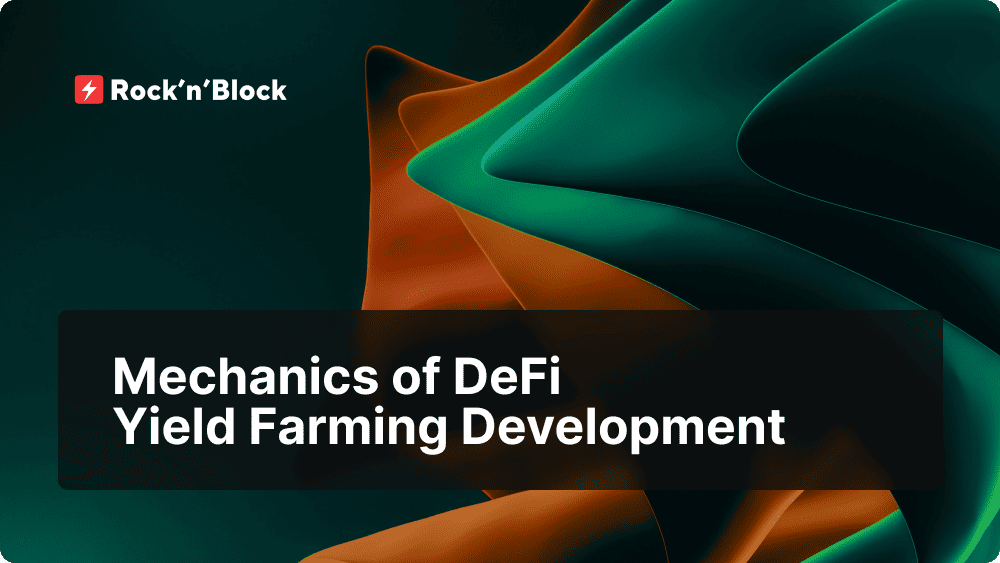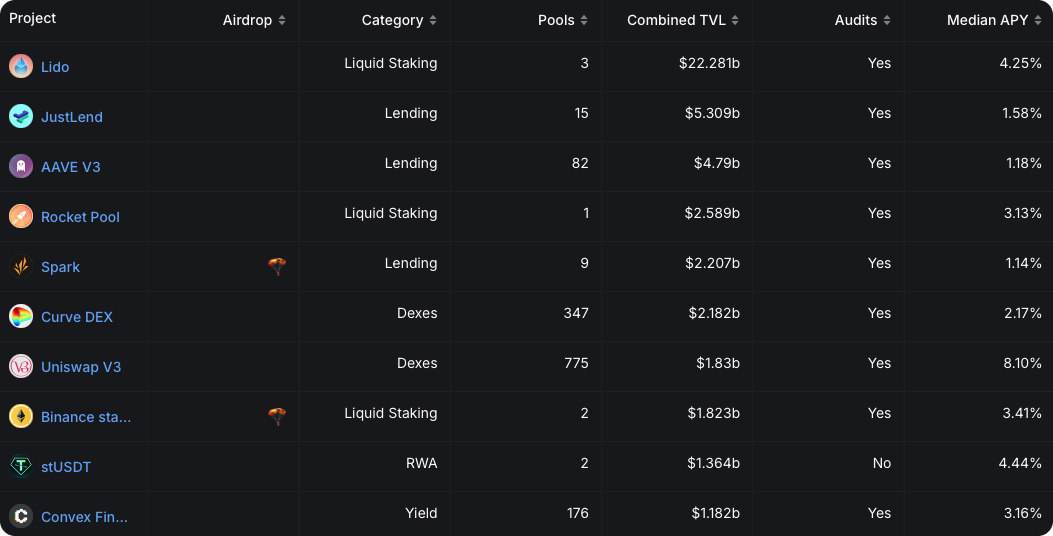Explaining Mechanics of DeFi Yield Farming Development
03 May 2024As decentralized finance continues to reshape the financial landscape, one practice has emerged as a cornerstone of its evolution: yield farming. In this article, we delve into the intricate mechanics of DeFi yield farming development, unraveling its complexities to provide a comprehensive understanding of how both users and project owners can harness its potential.

Table of Contents:
-
What is DeFi Yield Farming Development?
-
Mechanics of DeFi Yield Farming
-
Key Components of DeFi Yield Farming Development
-
How Does DeFi Yield Farming Work?
-
Examples
-
Conclusion
What is DeFi Yield Farming Development?
DeFi yield farming development refers to the practice of leveraging decentralized finance (DeFi) protocols to generate passive income by providing liquidity or participating in various yield-generating activities. It involves users staking or locking up their crypto assets within DeFi protocols in exchange for rewards, which can include additional tokens, trading fees, or governance rights. DeFi yield farming development has gained popularity due to its potential for high returns, although it also carries risks such as impermanent loss and smart contract vulnerabilities.
Explore our comprehensive article: Unveiling DeFi Protocols: The Power of DEX V3 Development!
Benefits for Users
DeFi yield farming development addresses the pressing need for users to maximize returns on their crypto assets in a decentralized manner. Traditional financial systems often offer limited avenues for earning interest on holdings, with centralized entities controlling the majority of wealth accumulation mechanisms. DeFi yield farming development democratizes this process, enabling users to earn rewards by participating in liquidity provision and other activities within decentralized protocols.
Benefits for DeFi Platform Owners
For DeFi platform owners, yield farming development presents a solution to liquidity challenges and user acquisition. By incentivizing liquidity provision through farming opportunities, platforms can deepen their liquidity pools and attract more users. Additionally, yield farming mechanisms can enhance platform governance by aligning the interests of token holders with the overall success of the protocol.
DeFi yield farming platform development also boosts Total Value Locked (TVL), enhancing credibility and attracting users and provides monetization avenues through native DeFi token issuance, partnerships, and protocol integrations, ensuring long-term financial sustainability and growth.
Read more about how yield farming platforms can lead companies to the forefront of financial innovation in our recent article: Why Do DeFi Platforms Need Yield Farming Development?
Mechanics of DeFi Yield Farming
The section below explores key components and processes involved in DeFi yield farming development, including smart contracts, the role of LP tokens, rewards structures, and user interfaces, essential for navigating the dynamic world of DeFi.
Key Components of DeFi Yield Farming Development
The Role of Smart Contracts Development
At the heart of DeFi yield farming development are smart contracts, self-executing contracts with the terms of the agreement directly written into code. Smart contract development automates various processes within yield farming, including reward distribution and staking.
Yield farming smart contracts prescribe the conditions for counting rewards, entry, and exit policies. Rewards are calculated within the contract based on these conditions, ensuring transparency and accuracy.
Moreover, the smart contract handles validation processes, facilitating functions such as withdrawal/unstake. It validates user addresses and tracks deposited amounts, ensuring fair and efficient distribution of rewards based on individual contributions.
Explore the important role of smart contracts, different types of DeFi yield farming, development features, and a step-by-step process for creating robust yield farming smart contracts in our Guide to DeFi Yield Farming Smart Contract Development!
The Role of LP Tokens
LP (Liquidity Provider) tokens represent ownership rights in a specific liquidity pool and are generated when users deposit pairs of tokens into the pool. LP tokens are typically issued in a 1:1 ratio with the tokens provided, ensuring that each LP token holder maintains a proportional share of the liquidity pool.
LP Tokens Types
In traditional automated market makers (AMM) systems, LP tokens are issued as ERC-20. This ensures equal use of liquidity where assets are pooled and trading commissions are distributed based on providers' shares in the pools.
In concentrated liquidity DEXes like Uniswap v3, where liquidity providers define specific conditions for their liquidity usage. For example, a provider may set a token value range, indicating that their liquidity will only be used within that range.
This customization makes LP tokens non-fungible, as each token represents unique liquidity positions. To accurately calculate commissions and validate the terms of liquidity deposits, providers receive LP tokens with distinct characteristics, usually ERC-721 tokens.
Rewards Structure
In DeFi yield farming development, rewards are often distributed in the form of additional tokens or fees collected within the protocol. Rewards in DeFi yield farming are typically calculated based on various factors, including the size of the liquidity pool, the duration of participation, and the overall activity within the protocol. Smart contracts automate the process of reward calculation, ensuring transparency and accuracy in the distribution of incentives to participants.
APY (Annual Percentage Yield) and APR (Annual Percentage Rate)
APY and APR are important metrics for calculating the potential return on investment in yield farming. APY reflects the annualized return, accounting for compounding, while APR represents the simple annualized rate of return. These metrics provide users with insights into the profitability of participating in DeFi yield farming activities.
Longer Pays Better/Bigger Pays Better
Some yield farming protocols employ a "longer pays better" or "bigger pays better" mechanism to incentivize long-term or larger liquidity provision. In such structures, providers who stake their assets for extended periods or contribute larger amounts may receive higher rewards or bonuses, encouraging sustained participation and larger capital injections.
Entry Policy/Exit Policy
Entry and exit policies establish the terms and conditions for joining or leaving a yield farming pool. Entry policies in DeFi yield farming development may require minimum deposit amounts or lock-up periods, while exit policies may stipulate withdrawal fees or cooldown periods. These policies maintain liquidity stability and prevent sudden fluctuations caused by mass entry or exit.
Multipliers
Multipliers are factors added to rewards to encourage certain behaviors or contributions. For instance, a protocol may offer higher reward multipliers for providing liquidity to pools with lower liquidity levels or for staking a specific token. Multipliers increase flexibility in designing reward structures that are tailored to desired outcomes and user behaviors.
Governance Rewards
In addition to monetary rewards, participants may also receive governance rewards for actively participating in the governance process of the protocol. These rewards can take the form of additional tokens or voting power, incentivizing users to engage in decision-making processes
Overall, a well-designed rewards structure in DeFi yield farming development aims to optimize incentives for liquidity provision while maintaining stability and sustainability within the ecosystem.
User Interface
The user interface (UI) in DeFi yield farming development is essential for providing a seamless and intuitive experience for participants. It serves as the primary point of interaction between users and the underlying protocols, enabling users to easily navigate through various functionalities such as providing liquidity, staking assets, monitoring rewards, and participating in governance activities.
A well-designed UI enhances accessibility and usability, attracting both novice and experienced users to engage with DeFi platforms. Intuitive UI features, such as clear navigation menus, informative dashboards, and user-friendly transaction prompts, streamline the user experience and empower participants to effectively manage their assets and maximize their earnings.
How Does DeFi Yield Farming Work?
DeFi yield farming development has revolutionized the landscape of decentralized finance, offering users opportunities to earn passive income through various strategies. Understanding how DeFi yield farming works is essential for those looking to participate in this ecosystem.
Step 1: Providing Liquidity
Users begin by providing liquidity to a designated liquidity pool by depositing pairs of tokens into a smart contract.
Step 2: Receiving LP Tokens
In exchange for providing liquidity, users receive LP tokens representing their share of the pool. These tokens serve as proof of ownership and entitle holders to a portion of the rewards generated by the protocol.
Step 3: Staking LP Tokens
To start yield farming, users stake their LP tokens in designated smart contracts, committing them to the protocol for a specified period.
Step 4: Farming Rewards
Throughout the farming period, users earn rewards in the form of additional tokens or fees generated by the protocol. These rewards are automatically credited to their accounts based on their staked LP token holdings.
Step 5: Withdrawal Process
At the end of the farming period or upon reaching a desired level of earnings, users can withdraw their staked LP tokens and accrued rewards from the protocol.
Auto-Compound Farming: Some DeFi projects offer auto-compound mechanisms, where earned rewards are automatically reinvested back into the liquidity pool, compounding returns over time. This feature allows participants to maximize their earnings without the need for manual intervention.
Examples
Yield farming is widely adopted on the Ethereum network, primarily using ERC-20 tokens as the primary tool. It is used in various platforms within Ethereum's ecosystem, such as decentralized exchanges (DEXs), lending and borrowing protocols, and liquid staking providers.
Notable platforms where yield farming is prevalent encompass:
Decentralized Exchanges: Curve Finance, Uniswap, Balancer, Thorchain.
Lending Protocols: Aave, JustLend, Spark, Compound.
Liquid Staking: Lido, Rocket Pool, Binance Staked ETH, Coinbase Staked ETH.
The following list ranks the top 10 DeFi platforms that facilitate yield farming based on Total Value Locked (TVL), as reported by DeFiLlama on February 6th, 2024.

Source: DeFiLlama
Conclusion
As DeFi yield farming continues to evolve, it presents exciting opportunities for both users and platform owners to participate in the democratization of finance and shape the future of decentralized finance. By staying informed, exercising caution, and embracing innovation, stakeholders can navigate the complexities of DeFi yield farming development and unlock its full potential for financial empowerment and inclusion.
We ❤️ Development
Follow us on social media to receive the hottest blockchain development updates
Twitter ⚡️Telegram⚡️LinkedIn⚡️Facebook







